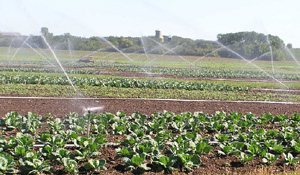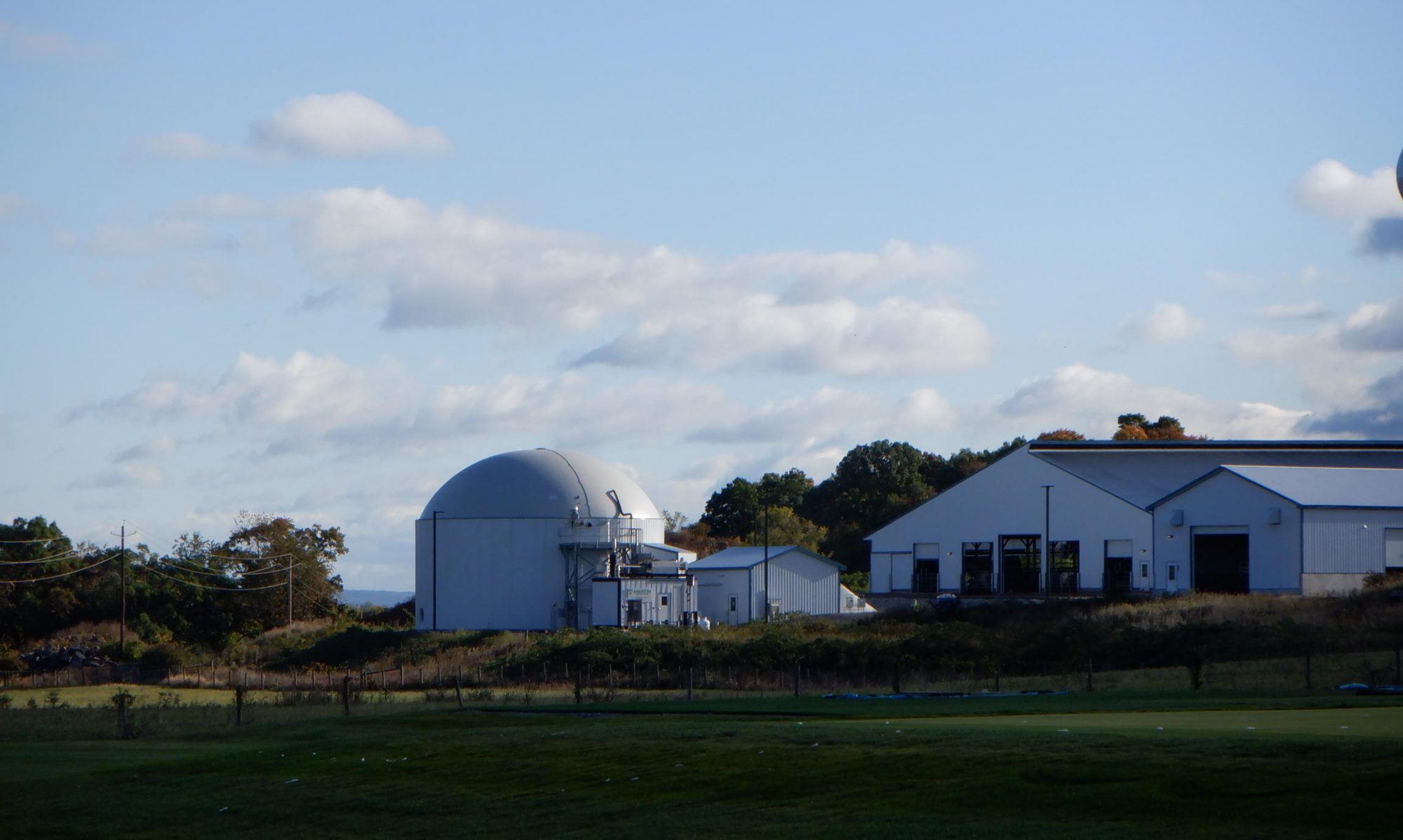|
|
|
Irrigation is Nevada. Photo: US EPA and National Archive and Record Administration; Wikimedia Commons. |
Learn how efficient irrigation technologies and practices reduce water and power costs.
Table Of Contents
Energy Efficient Irrigation

![]() Find these topics and many other related Farm Energy media resources at the Farm Energy Media archive.
Find these topics and many other related Farm Energy media resources at the Farm Energy Media archive.
Irrigation is very important to productive agriculture, accounting for 20% of all farmland and 40% of all production worldwide. This is the major use of water in the world, accounting for about 70% of all freshwater use. Efficient irrigation systems use energy-efficient equipment and designs, and also minimize the amount of unnecessary water use, adding to the energy savings. As a result, farms that irrigate efficiently will not only reduce their operating costs but will also reduce the use of water resources that are increasingly scarce. There are two main ways a farm can improve the efficiency of its irrigation efforts: 1) improving the irrigation system, and 2) enhancing the management and operations of the system.
Irrigation System Improvements
Modifying irrigation systems can reduce energy and costs. For example, according to the Natural Resources Conservation Service (NRCS), in certain areas of the United States, switching from high- to low-pressure sprinkler systems can save as much as $55 and 770 kWh per acre annually. In areas where ground and surface water availability is diminishing, efficient irrigation tools such as drip, trickle and lower-flow sprinkler systems save energy as well as water and money.
Some common causes of wasted energy in irrigation systems are worn or improperly sized pumps, worn nozzles, and improperly sized or designed fittings. Irrigation equipment problems and maintenance problems tend to go hand in hand. Pumps, motors, and engines that are badly designed or poorly maintained reduce the irrigator’s degree of control over water applications, making it impossible to maintain correct soil moisture levels. This leads to crop stress, reduced yields, runoff, erosion, and other problems.
Irrigation Management Improvements
On the other hand, mechanical improvements alone do not necessarily bring energy savings. Better system performance typically causes higher pressure and increased volumes of applied water. These improvements should make it possible to meet crop water needs with fewer hours of irrigation. But if the irrigator continues to run the system for the same number of hours, energy consumption often stays the same or even increases.
In order to avoid both overwatering and underwatering, all irrigators need to know their system’s net water application rate, measured in inches per hour or inches per irrigation. All irrigators should know general irrigation guidelines for the crops they grow. They should also know how to check their soil moisture levels. Most irrigators should also track crop water use, or evapotranspiration, as the season goes by.
An Irrigation Checklist is available to help with the optimization of irrigation system efficiency.
Summary
Farmers should examine their irrigation equipment and practices to ensure that their irrigation systems operate efficiently. To use energy in irrigation most efficiently, irrigators should:
- Modify irrigation systems for greatest efficiency
- Repair and maintain equipment to reduce wasted energy
- Understand irrigation usage and rate, and irrigation guidelines for crops
- Understand how to check soil moisture levels.
- Track water use of crops throughout the growing season
For Additional Information
The following links provide a wealth of information on energy efficient irrigation equipment and practices:
Tools and Guides for Efficient Irrigation
- Irrigation Scheduling Checkbook Method. University of Minnesota Extension. Tutorial on how to do irrigation scheduling.
- Irrigation Efficiency Publications from the National Sustainable Agriculture Information Service (ATTRA), detailing how to save energy and reduce irrigation costs:
- Irrigation Engineering Univ. of Nebraska
- Smart Water Use on Your Farm or Ranch SARE Bulletin includes Soil, Plant and Water management.
- Management of Irrigation Systems Georgia Farm-A-Syst Publication B1152-05, 2009. Assessment Tool to manage water quality issues.
- Energy Estimator: Irrigation NRCS tool to estimate energy cost of pumping water on your farm or ranch.
- Energy Self Assessment Tool: Irrigation Web-based energy assessment tool to estimate the energy use and suggest ways to reduce energy use and cost for all irrigation systems.
- Efficient Irrigation Planning:Factors To Consider Alabama Cooperative Extension System, Alabama Irrigation and Water Resources, Auburn University
- NRCS Irrigation Page Natural Resource Conservation Service. Includes information on water management models and irrigation components.
- Center for Irrigation Technology (CIT) Independent research and testing facility assists designers, manufacturers and users of irrigation equipment.
- Irrigation Testing University of Wisconsin, Madison. Various resources include uniformity testing procedure and spreadsheet for calculating Coefficient of Uniformity.
- Care and Maintenance of Irrigation Wells. North Dakota State University Extension Service, AE-97. Fargo, ND, 2005.
Irrigation Practices, Scheduling
- Soil, Water and Crop Characteristics Important to Irrigation Scheduling North Carolina Cooperative Extension Service, AG 452-1, 1996.
- Scheduling Irrigation details Water Balance Method, Soil Moisture Measuring, Computer Models, and Charting. University of Georgia Cooperative Extension, Bulletin 974, 2009.
- Irrigation Flow Measurement Louisiana State University Agricultural Center
- Irrigation Scheduling Made Easy: Using the ‘Look and Feel’ Method Louisiana State University Agricultural Center.
- Estimate Soil Moisture by Feel and Appearance Natural Resource Conservation Service.
- Irrigation Scheduling: The Water Balance Approach Colorado State University Extension. Determinating Irrigation Need, Estimating Soil Water Content.
- Irrigation Scheduling: Evaporation Pans Still Work! Montana State University Extension.
- The UGA EASY (Evaporation-based Accumulator for Sprinkler-enhanced Yield) Pan Irrigation Scheduler is designed to provide in-field monitoring of crop water needs in humid areas for a fraction of the management time and cost associated with other irrigation scheduling methods; based on the direct relationship between pan evaporation and soil water removal. University of Georgia Cooperative Extension, Bulletin 1201, 2009.
Renewable Power Sources for Irrigation
- Solar Powered Livestock Watering Systems Agricultural Extension Service, University of Tennessee.
- Economic Modeling Tool for Wind Applications on Irrigation Systems Montana State University. Excel spreadsheet allows producers to compare up to three different sizes of wind turbines for up to four different types of irrigation systems.
Irrigation Equipment
- Improve Efficiency of Irrigation Pumping Plants University of Nebraska Extension
- Water Loss from Above-Canopy and In-Canopy Sprinklers University of Nebraska. In-canopy and above-canopy sprinklers are compared to determine which irrigation method minimizes water loss and reduces installation and operation costs.
- Maintaining Electric Motors Used for Irrigation Utah State University Cooperative Extension. This fact sheet describes factors that affect electric motor performance and service life and describes procedures for controlling internal motor heat.
- Maintenance of Wheelmove Irrigation Systems Utah State University Cooperative Extension. This bulletin describes regular maintenance activities including pre-operational procedures, a schedule of regular maintenance, and guidelines for winter storage, that will maximize the life of wheelmove systems and keep irrigation efficiency at design levels.
- Irrigation Water Pumps. North Dakota State University Extension Service, AE-1057 Fargo, ND. 1993.
Regional Irrigation Guides
- TexasET A Project of the Irrigation Technology Center. Texas A&M AgriLife Extension. Contains weather information, current and average evapotranspiration data, and irrigation watering recommendations.
- Irrigation in the Pacific Northwest – Scheduling Aids and Tools. Resources provided by Washington State University Extension, Oregon State University Extension, and University of Idaho Extension. Includes a variety of practical and useful tools referenced here depending on what works best for your particular skills, operation, habits, and preferred methods of doing business.
- KanSched – An ET-Based Irrigation Scheduling Tool for Kansas Summer Annual Crops. Kansas State Extension and Research
- Irrigation Scheduling Tools. Michigan State University Extension and Purdue University. Four different checkbook irrigation scheduling tools that will adapt to irrigation in the Michiana area.
Irrigation Information by Crop
- Successful Potato Irrigation Scheduling. Oregon State University Extension Service, EM 8911, 2006.
- Irrigation Scheduling of Grapevines with Evapotranspiration Data. Texas A&M AgriLife Extension.
- Irrigation Scheduling for Corn — Why and How. National Corn Handbook, Iowa State University.
Contributors to this Article
Authors
- Mike Morris, National Center For Appropriate Technology (ATTRA)
- Vern Grubinger, Professor, University of Vermont Extension
Peer Reviewers
- Daniel Ciolkosz, Extension Associate, Penn State
- Carl Pederson, Energy Educator, North Dakota State University


